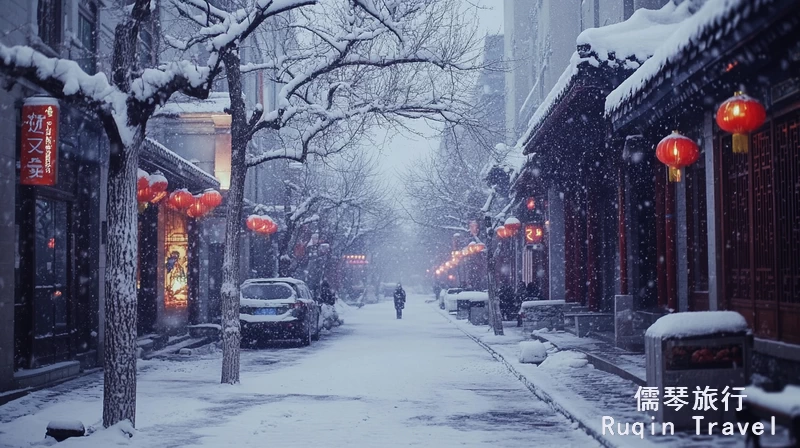China’s vast and diverse landscape offers a wide range of weather and climate experiences. From the cold winters in the north to the tropical climate in the south, understanding China’s weather patterns can significantly enhance your travel experience.
This guide will provide you with all the necessary information, including seasonal weather, regional climate zones, and tips on how to prepare for your trip on the climate and weather in China.
Understanding China’s Climate Zones
China’s size and topography create diverse climate zones. In the north, you’ll find cold winters and hot summers. For instance, Beijing weather can be harsh in winter, with temperatures dropping to -10°C. However, summers are hot, with temperatures reaching up to 30°C.
In the south, the climate is subtropical to tropical. Guangzhou weather, for example, features hot, humid summers and mild winters. The monsoon season here brings heavy rainfall from May to September. In the west, Tibet weather conditions are unique due to high altitudes. Summers are mild, while winters can be extremely cold.
Eastern China, including Shanghai, experiences a humid subtropical climate. Shanghai climate has hot, humid summers and cool, damp winters. Northeastern regions, such as Harbin, experience cold winters with heavy snowfall and mild summers. Understanding these climate zones will help you pack accordingly and plan your trip at the best time.
China’s Four Seasons
Spring in China, from March to May, is a delightful season. Flowers bloom, and temperatures rise, making it a popular time for tourists. However, spring can be unpredictable, with sudden rain showers. Therefore, packing a light jacket and an umbrella is advisable.
Summer, from June to August, is hot and humid, especially in the south. China’s monsoon season occurs during this period, bringing heavy rain and occasional typhoons. However, northern areas like Beijing are dryer but still hot. Summer is an excellent time for visiting high-altitude regions like Tibet, where the weather is milder.
Autumn, from September to November, is considered the best time to visit China. The weather is pleasant, with clear skies and moderate temperatures. Autumn foliage, especially in regions like Jiuzhaigou and the Great Wall, offers stunning scenery. Additionally, there are fewer tourists during this season, making it a more enjoyable experience.
Winter, from December to February, varies significantly across the country. Northern China experiences freezing temperatures and snow, making it a perfect destination for winter sports. For example, Harbin weather is ideal for the famous Harbin Ice Festival. In contrast, southern regions like Guangzhou have mild winters, with temperatures rarely dropping below 10°C.
Regional Weather Highlights
Beijing experiences four distinct seasons. Spring and autumn are the best times to visit, with comfortable temperatures and less pollution. However, winters are cold and dry, while summers are hot and humid. Therefore, dressing in layers and staying hydrated is crucial.
Shanghai has a subtropical climate with hot, humid summers and cool winters. The city experiences a lot of rain, particularly during the monsoon season. Spring and autumn are ideal for visiting Shanghai, with pleasant weather and fewer crowds.
Guangzhou, in southern China, has a tropical climate. The weather is hot and humid year-round, with a monsoon season from May to September. Winter in Guangzhou is mild, making it a great escape from colder regions.
Tibet offers a unique climate due to its high altitude. Summers are mild, but nights can be cold. Winters are harsh, with heavy snowfall and freezing temperatures. Therefore, it’s essential to pack warm clothing, even during summer visits.
Harbin, located in the northeastern part of China, is famous for its cold winters and the Ice Festival. The city experiences heavy snowfall and freezing temperatures from November to February. Summers are mild, making it a pleasant time to explore the city’s historical sites.
Best Time to Visit China
Determining the best time to visit China depends on your interests and the regions you plan to explore. Spring (March to May) and Autumn (September to November) are generally the best times to visit. The weather is mild, and the landscapes are beautiful. However, these seasons are also popular among tourists, so expect crowds at major attractions.
Summer (June to August) is suitable for visiting mountainous regions like Tibet, where the weather is more comfortable. However, be prepared for hot and humid conditions in the lowlands, especially in southern cities like Guangzhou.
Winter (December to February) is ideal for visiting northern China, especially if you’re interested in winter sports or festivals. The Harbin Ice Festival is a major attraction during this time. However, the cold weather can be challenging, so pack accordingly.
Weather Tips for Tourists
- Pack Accordingly: Understanding the climate of the region you’re visiting is crucial. For instance, if you’re traveling to Beijing in winter, pack heavy coats, gloves, and hats. On the other hand, for southern cities like Guangzhou, lightweight and breathable clothing is suitable.
- Check the Forecast: Always check the local weather forecast before your trip. This helps you prepare for unexpected weather changes, such as sudden rain showers in spring or summer storms.
- Hydration and Sun Protection: In hot and humid regions, staying hydrated is essential. Carry a water bottle and drink plenty of fluids. Additionally, use sunscreen and wear a hat to protect yourself from the sun.
- Layering: Especially in regions with significant temperature variations, layering is a practical choice. This way, you can easily adjust to changing weather conditions throughout the day.
- Stay Informed: Keep an eye on local news and weather updates, especially during the monsoon season or winter storms. This is particularly important in regions prone to extreme weather, such as typhoons in the south or heavy snowfall in the north.
- Respect Local Customs: When visiting religious or cultural sites, dress modestly and respect local customs. This is especially important in regions like Tibet, where traditional customs are deeply respected.
China’s diverse climate and weather patterns offer something for every traveler. Whether you’re exploring the bustling streets of Beijing, the historical sites of Shanghai, or the scenic landscapes of Tibet, understanding the climate and weather in China will enhance your experience. From the harsh winters in the north to the tropical climate in the south, China’s weather is as varied as its culture. By preparing adequately and choosing the best time to visit, you can enjoy a comfortable and memorable trip.
In conclusion, this guide has provided an overview of the climate and weather in China with its zones, seasonal weather, and tips on preparing for your journey.
By understanding the various weather patterns and conditions, you can plan your trip effectively and make the most of your visit to this fascinating country. Whether you’re a first-time visitor or a seasoned traveler, China offers a unique blend of natural beauty, cultural heritage, and modern marvels that are sure to leave a lasting impression.



